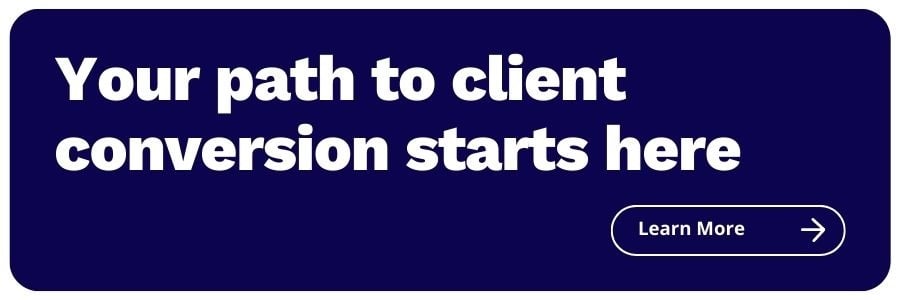8 Totally Avoidable Marketing Mistakes Independent Financial Advisors Make
Share this
How do you get better at marketing? By learning from your mistakes.
Or better yet, by learning from the mistakes of others.
Marketing your firm is one of the most exciting parts of owning a business (no really, I swear). But it's also very unlikely you became an independent financial advisor because you love marketing.
For many firm owners, especially those who are completely new to marketing, it also involves a lot of trial and error. Wouldn't it be nice if your marketing could involve more intentional trial and less unintentional error?
Lucky for you, it can. You simply need to know what major downfalls to dodge.
Here are eight common mistakes you should avoid when marketing your firm.
Mistake #1: Not Having a Marketing Plan
It doesn’t have to be elaborate, but it does need to exist.
Trying to promote your firm and build your business without a marketing plan is like trying to find a blue shirt blindfolded (a very difficult task unless you're Michael Kitces). Sure, you could get lucky and bring in some new clients, but you’ll likely waste a lot of time, and potentially money, in the process.
A marketing plan forces you to think and get clear on your goals. The act of composing a marketing plan pushes you to clearly articulate your service(s) and your target clientele, and how you bring those two things together.
Additionally, a marketing plan will help you market more efficiently and effectively, making the most out of your time and money. It creates a set of measurable goals and helps you organize your time and priorities, which means less time and money thrown down the drain.
Lastly, a marketing plan offers a reality check between your business objectives and your marketing strategy. Whatever your business objectives are, your marketing plan needs to support them.
Sure, a marketing plan takes time and effort, but the work you put into developing a plan on the front end will pay off in the long run.
Mistake #2. Not Having a Differentiator
I realize the horse is long dead by now, but that won’t stop me from saying it: you should be marketing to a niche.
Once upon a time, just being a CFP® was enough of a differentiator to claim your corner of the market and bring in clients. But with the percentage of financial advisors earning their CFP® certification on the rise, those days are in the past.
To market your firm effectively, you need to understand what sets you apart from the competition—this is called your unique value proposition. Your unique value proposition identifies what makes your firm the right choice and clearly conveys why your target clients should choose you over another advisor.
Understanding your differentiator and identifying a niche will help you narrow the scope of your marketing to a specific group so you can use targeted messaging that will resonate with them.
You may think that by narrowing your group of potential clients you’ll also narrow your group of actual clients—fewer prospects equals fewer clients, right? Wrong.
When you cast the net wider, you often end up with fewer actual clients.
Focusing on a target clientele will allow you to focus on getting in front of the right prospects; the ones who have the greatest likelihood of converting to clients.
So get clear on your niche and stop spinning your wheels trying to market yourself to someone who will never be a fit. It’s a waste of your time, and theirs.
Mistake #3. Being Afraid to Try New Things
Most of us have an innate fear of the unknown. We’re also creatures of habit. That’s just human nature. But there’s no place for that in marketing—at least not in successful marketing.
Marketing is always evolving, which means to be an effective marketer, you need to be responsive and flexible. If you get stuck in your routines, you’ll quickly fall out of sync with changing times and will miss opportunities to promote your firm.
That doesn’t mean you should abandon your tried and true tactics. You know what they say: if it ain’t broke, don’t fix it. But you should be consistently monitoring and measuring your marketing efforts so you can tweak things that aren’t working, or switch gears if an effort appears to be a lost cause.
Have you seen a lot of success from organic social media efforts? Try to harness that success through some paid social ad experimentation.
Could your website use a refresh? Explore a website redesign.
Do you want to bring more prospects into your funnel? Offer a free download or create an email opt-in on your website.
Are you looking to make more industry connections? Register for a conference.
There’s no shortage of marketing tactics you can try. Looking for some inspiration? Check out our blog 12 Months of Marketing Goals for Independent Financial Advisors.
Mistake #4. Not Having a Good Website (Or Not Having One at All)
You need a website. Period. End of story.
Most prospective clients will try to find and learn more about your services through the web long before they ever communicate with you directly. If you don’t have a website, you may lose out on potential clients to another financial advisor who does.
And if you don’t have a good website, you aren’t doing yourself any favors when it comes to converting prospects into clients. From the minute a prospect hits your home page, they’re sizing you up, scrutinizing you and your firm online.
Choosing a financial advisor is a major decision that requires serious contemplation. If your website doesn’t make a positive impression, build trust, and speak to your prospective clients, you might as well not have one because it’s simply not doing its job.
In today’s digital age, websites are no longer super complicated nor expensive to build. If you have at least a basic understanding of UX and UI, you can DIY the job through platforms like Wix or SquareSpace.
If you don’t even know what UX and UI mean, I highly recommend spending the money to work with a web designer.
Why? Because they’ll not only design a visually compelling and easily navigable website, but they’ll help you avoid the next marketing mistake, which is…
Mistake #5. Not Employing an SEO Strategy
Having a website is essential. But it’s not enough. Your website will rank higher on relevant queries with the right SEO (search engine optimization) strategy. Without it, you could end up with a killer website that no one ever sees.
Any legitimate web designer will know their stuff when it comes to SEO strategy. They’ll know which keywords to use (and how/where to insert them into your website’s code), how to write high-performing meta descriptions and title tags, the best alt text to use, and more.
Can’t afford a web designer right now? No big deal. You’ll just need to spend some time learning the basics. Learn more about maximizing your SEO strategy.
Mistake #6. Not Having a Blog
Sure, there are successful independent financial advisors who don’t have blogs. But the most successful ones do.
A blog helps you establish yourself as an expert and reach and connect with potential (and current) clients. When you write your own content, you can leverage it to build trust, provide value, and generate leads.
Your blog is a chance to show firsthand that you really “get” your prospective clients, and understand their pain points, wants, and needs. It’s also a chance to position your website as the relevant answer to your prospects’ questions.
Here are some tips as you get started:
- Don’t be afraid to give away too much (but be sure you leave your readers wanting more). Think of your blog as a way to show prospective clients how you can solve their problems, without actually solving all their problems right then and there—this is where the "leave them wanting more" piece comes into play. Sharing your knowledge helps prove your legitimacy to prospects and will go a long way towards showing your usefulness. Over time, prospects will start to see you (not just your blog) as the answer to their problems, at which point they'll become clients.
- Produce evergreen content. Writing a weekly blog is one thing. Maintaining that blog is another. Blog maintenance becomes much more manageable when you focus on producing evergreen content (i.e. content that remains relevant over time) that doesn’t need to be regularly updated.
- Don’t be salesy. Just don't. Your blog is not a direct sales tool; it’s a tool for building trust, demonstrating your usefulness, and, again, showing prospective clients that you actually know what you’re talking about.
- Do be strategic. Offer an email subscription option and consider taking things one step further by creating a gated content offer you can link to your blogs. Both of these things will give you access to something very valuable: your prospects’ email addresses.
- Never lose sight of your audience. Writing is not only easier when you make your client the central focus, it’s also most effective for lead generation. Consider your target clientele and craft content that taps into their core values, addresses their pain points, and offers solutions.
Don’t have a blog? Perhaps this is the “something new” you can try this year.
Mistake #7. Avoiding Networking Opportunities
Many advisors want to skip right over the networking stage of practice growth. It can be time-consuming, draining (and, depending on your personality, exceptionally draining), and sometimes downright awkward.
But while networking might not be at the top of your to-do list, it should at least be on it.
There’s no denying the influence a solid professional network can have on your career. Often the most connected people are the most successful.
That’s because networking is about more than exchanging words; it’s about establishing and nurturing mutually beneficial relationships.
So next time you’re thinking about skipping out on that conference because it’s not in the budget, or you don’t have the time, or whatever other excuse you’ve conjured up, think again.
Mistake #8. Not Reviewing Your Marketing Plan
Your marketing plan is not a “set it and forget it” kind of thing. It's an iterative process. That's because marketing itself is not, and never will be, a static endeavor. It requires long-term attention and care to set the pace of your firm’s growth.
Understanding the effectiveness of your marketing plan is perhaps more important than the plan itself.
As you review your plan, you should challenge assumptions, revisit your strategy, and contemplate lessons learned. Are there any changes you want to make to your materials, milestones, budget, or metrics? The review process is the time to do it.
If you aren’t consistently reviewing your analytics and checking the pulse of your marketing efforts, then you might as well not have a plan at all. Tear it up. It’s useless.
Have you been making any of the marketing mistakes above? That's okay. You don't know what you don't know.
But now that you do know what marketing mistakes you should avoid, it's time to focus on getting it right. Good luck!

About the Author
As XYPN’s Content Manager, Kelly Moorman is tasked with communicating the Network's value proposition to the world. For years, Kelly has helped organizations tell their stories in ways that inspire others to listen, and to care. Her penchant for a well-crafted sentence, good grammar, and clever wordplay has earned her the moniker “Word Whiz” around the XYPN office. She’s thrilled to share XYPN’s story with you and the rest of the world.
Share this
- Fee-only advisor (381)
- Advice (305)
- Business Development (248)
- Independent Financial Advisor (203)
- Growing Your Firm (161)
- Marketing (133)
- Financial Planning (129)
- What Would Arlene Say (WWAS) (81)
- Business Coach (80)
- Firm Ownership (78)
- Training (75)
- Compliance (72)
- Business (69)
- Building Your Firm (65)
- Financial Advisors (63)
- Online Marketing (61)
- Events (59)
- Starting a Firm (52)
- Staffing & HR (49)
- Technology (49)
- From XYPN Members (48)
- Launching a firm (46)
- Advisors (41)
- Entrepreneurship (38)
- Taxes (37)
- Networking & Community (33)
- Interviews and Case Studies (32)
- Investment Management (31)
- Sales (27)
- Social Responsibility (27)
- Tax Preparation (27)
- XYPN Invest (26)
- Business Owner (25)
- Small Business Owner (20)
- Financial Management & Investment (19)
- Industry Trends & Insights (19)
- Financial Education (17)
- Financial Planners (17)
- Independent Financial Planner (17)
- Tech Stack (17)
- XYPN (17)
- Leadership & Vision (16)
- Investing (15)
- Niche (15)
- How to be a Financial Advisor (14)
- NextGen (14)
- RIA (14)
- Media (13)
- Preparing to Launch (13)
- Press Mentions (13)
- RIA Operations (12)
- RIA Owner (12)
- XYPN Membership (12)
- Assets Under Management (AUM) (11)
- First Year (11)
- Goals (11)
- Scaling (10)
- Advisor Success (9)
- Building Your Firm (8)
- Communication (8)
- Lessons (8)
- Study Group (8)
- Time Management (8)
- Virtual Advisor (8)
- Behavioral Finance (7)
- Growth (7)
- Pricing Models (7)
- From Our Advisors (6)
- Independent RIA (6)
- Money Management (6)
- Motivation (6)
- Processes (6)
- Automation (5)
- Broker-Dealers (5)
- College Planning (5)
- Filing Status (5)
- How I Did It series (5)
- Investment Planner (5)
- Mental Health (5)
- Michael Kitces (5)
- Preparing to Launch (5)
- RIA Operations (5)
- Retirement (5)
- Risk and Investing (5)
- S Corpration (5)
- Support System (5)
- TAMP (5)
- Wealth (5)
- Year-End (5)
- Client Services (4)
- Outsourcing (4)
- Selling a Firm (4)
- Succession Plans (4)
- Benchmarking Study (3)
- Budgeting (3)
- Career Changers (3)
- Engagement (3)
- Fiduciary (3)
- Getting Leads (3)
- Membership (3)
- Millennials (3)
- Monthly Retainer Model (3)
- Partnership (3)
- Pricing (3)
- Recordkeeping (3)
- Risk Assessment (3)
- Small Business (3)
- Staying Relevant (3)
- Work Life Balance (3)
- Advice-Only Planning (2)
- Bookkeeping (2)
- Charitable Donations (2)
- Client Acquisition (2)
- Differentiation (2)
- Health Care (2)
- IRA (2)
- Inflation (2)
- Productivity (2)
- Implementing (1)
Subscribe by email
You May Also Like
These Related Stories

The Five Habits of Highly Successful Marketers: A Guide for Independent Financial Advisors

How to Create a Successful Blog as an Independent Financial Advisor




